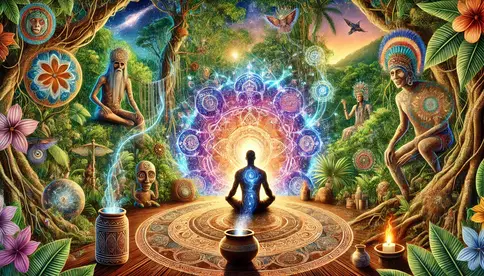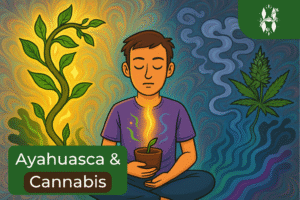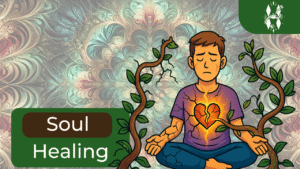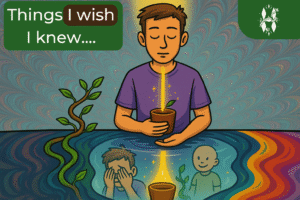There are many different plant medicines and substances that can put us in an altered state of consciousness. Understandably, we are curious about how these substances affect us, their benefits, and what we can expect from them. Should we try them? Which one fits us better? In this blog, we dive into the comparison between Ayahuasca and DMT.
Key takeaways:
Both Ayahuasca and DMT contain the psychedelic compound DMT. However, Ayahuasca includes MAO inhibitors that make the DMT orally active and prolong the experience, whereas DMT is usually smoked for a shorter, intense trip.
Indigenous communities see Ayahuasca as a sacred plant medicine facilitating a connection with the spirit world, beyond mere chemical reactions. They emphasize the spiritual and holistic aspects of the Ayahuasca experience over the scientific focus on DMT.
While both Ayahuasca and DMT have potential therapeutic benefits, Ayahuasca is known for its comprehensive healing process, including physical, emotional, and spiritual cleansing. Smoking DMT can offer quick insights.
Table of Contents
Disclaimer
We are all individuals with different backgrounds, past experiences, levels of intention, and maturity, among many other factors. While the mind often likes to compare and judge, it’s important to remember that each plant medicine offers its own unique angle of healing. What is shared in this blog (and in other blogs comparing different plant medicines) are general guidelines. These are not universal truths and may be perceived differently by each individual.
I just want to highlight that these are just guidelines. Ultimately, nothing can substitute for your own personal experience with a specific plant medicine.
Active Ingredient: DMT
Ayahuasca and DMT share the same major active ingredient: Dimethyltryptamine, commonly known as DMT. This powerful compound is often referred to as the “spirit molecule” in documentaries and literature due to its profound effects on consciousness. DMT is known for inducing intense, often spiritual experiences, where individuals report seeing divine beings, connecting with higher consciousness, or experiencing alternate dimensions. This unique ability to facilitate such deep and transformative experiences naturally sparks interest in those curious about exploring altered states of consciousness.
In Ayahuasca, DMT is derived from specific plants, typically combined with a MAO inhibitor to make it orally active and prolong the experience. In its pure form, DMT is usually smoked or vaporized, leading to a much shorter, but equally intense journey.
The Indigenous Viewpoint on Ayahuasca vs DMT
When discussing Ayahuasca with indigenous communities, they often express discomfort with the idea that DMT alone is responsible for all the effects of Ayahuasca. For them, this perspective represents a form of scientific rationalisation and simplification of the plant, just as a way to explain it using the logical mind. However, these profound experiences are not meant for the logical mind to dissect; they are for the spirit to receive and begin transforming our inner being.
Indigenous masters have historically achieved remarkable feats with Ayahuasca, viewing it not just as a chemical interaction but as a sacred guide. A recent example that highlights this made international headlines: when a plane crashed in the Amazon, an indigenous elder master drank Ayahuasca to aid in finding the crash site. Remarkably, he was able to locate the wreckage and save the surviving children, where the radar technology wasn’t working.
This story emphasizes the indigenous’ ability to connect with the spirit of the jungle and other plants, reinforcing their belief that Ayahuasca facilitates a connection with the spirit world, guiding and healing them in ways beyond mere chemical reactions. For indigenous people, Ayahuasca is far more than a substance that induces “hallucinations”; it is a spiritual tool that helps them navigate and understand their world. This holistic approach contrasts with the Western tendency to reduce the experience to its biochemical components.
You can find out more about the indigenous perspective on the blog: What is Taita?
To add – there are more than 13 different alkaloids in Ayahuasca, suggesting a complexity far greater than the DMT reaction alone.
Must read blog: How does Ayahuasca affect the brain?
Find out if Ayahuasca is right for you
- Will you be safe physically and emotionally?
- How will you be supported in the ceremony?
- How do the facilitators handle difficult situations?
- How will you be able to process the experience?
- You want change, but will your life be unrecognizable after Ayahuasca?
+ 13 things to consider before drinking Ayahuasca?
Smoking DMT
In my early 20s, I personally smoked DMT a few times. To be honest, nothing too spectacular happened. I saw some colors, but I never really “broke through.” I tried it in introspective settings as well as casually on a friend’s couch while hanging out. Looking back, I’m glad I didn’t break through because I don’t think I was truly ready for that experience.
Many people who smoke DMT can be considered “psychonauts” – individuals keen on exploring their consciousness. While there is often an introspective element, there’s usually a significant overlap with the recreational use of psychedelics. I’ve had participants at retreats who were somewhat regular users of DMT. Initially, they reported similarities between Ayahuasca and DMT. One person even expressed disappointment, saying he expected more from Ayahuasca and felt he could have had similar experiences without traveling thousands of miles. However, in the following Ayahuasca ceremony, the intensity increased significantly, giving him an experience unlike anything he had encountered before. This has happened with multiple people who have tried both DMT and Ayahuasca.
This shift often occurs when there is a lack of respect for Ayahuasca. Either nothing significant happens, or the Ayahuasca experience becomes very intense, emphasizing its non-recreational nature and perhaps highlighting the underlying reasons for seeking substance-induced experiences in the first place.
Ayahuasca vs DMT: Chemically Extracting the Experience
From my limited perspective, smoking DMT feels like a bit of a shortcut. It’s comparable to the difference between LSD and magic mushrooms. Both have similar active components, but those who have tried both can sense the difference – the “spirit” is often felt to be missing in LSD. That’s the sense I get from smoking DMT. Typically, people who smoke DMT might ask why they would choose Ayahuasca, with its side effects like vomiting, when they can achieve “the same” effects by smoking DMT without the inconveniences. However, they may not understand that the purge is an essential part of the Ayahuasca experience.
Must read blog: Ayahuasca and purging
Healing Aspects of Smoking DMT
There is a person I know, though not in my inner circle, who has been drinking Ayahuasca for around ten years and also shares DMT. This initially surprised me, so I spoke with him about it. He explained that smoking DMT can be very helpful when someone has a specific question and wants to look behind the curtain, seeking a spiritual download or insight on that topic.
I can see the truth in his statement, and it serves as a powerful reminder for me that there are various ideas and conceptions around plant medicines. It’s easy to fall into the mindset of thinking, “this is the right way,” “this is the traditional way,” or “this is how one needs to use plant medicines.” While there is some truth to these notions, it’s only partial. Ultimately, what is important is that the practice works for the individual and brings benefit to their personal life while maintaining respect for the traditions.
So, I guess the takeaway is to explore what works for you. Connect with your heart and intuition, and follow that guidance. Each person’s journey with plant medicines is unique, and finding what resonates with you is key to receiving the most benefit.

The Power of an Ayahuasca Ceremony vs DMT
With Ayahuasca, it’s not just about the substance we drink; it’s about the intentional approach that surrounds the entire experience. The journey begins with the diet and preparation beforehand, which helps purify the body and mind in anticipation of the ceremony. Finding your intention is crucial, as it sets the stage for the journey you are about to undertake. It’s also about connecting with the sacredness of the ceremony, honoring the indigenous traditions that have safeguarded these practices for hundreds, if not thousands, of years.
The ceremony itself is much more than the chemical activation of DMT. It includes the purging element, which cleanses not only the physical body but also provides a spiritual and energetic cleanse. Being in the ceremony for many hours allows for deep introspection, profound realizations, and the development of new understandings and connections.
The power of an Ayahuasca ceremony lies in the holistic approach that encompasses preparation, intention, gratitude, and the deep spiritual and physical cleansing it offers. It’s hard to articulate in the right words, but I hope this gives you a sense of the profound difference between a mere chemical experience and the rich, multifaceted journey that an Ayahuasca ceremony provides.
Must read blog: Ayahuasca ceremony – what to expect
Conclusion
In conclusion, while both Ayahuasca and DMT share the active ingredient DMT, the experiences they offer can be profoundly different. Ayahuasca, rooted in deep indigenous traditions, involves a holistic and intentional approach that goes far beyond the chemical effects. The preparation, setting, intention, and the sacredness of the ceremony contribute to its powerful transformative potential. Smoking DMT, while offering rapid and intense experiences, often lacks the broader context and spiritual depth that Ayahuasca ceremonies provide.
Ultimately, the right path depends on the individual. It’s essential to approach these substances with respect and mindfulness, recognizing the unique benefits and lessons they each offer. Whether you choose to explore Ayahuasca in a traditional ceremonial setting or DMT in a more controlled environment, the key is to honor the experience and integrate its insights into your life.
FAQs
What is the difference between Ayahuasca and DMT?
Ayahuasca and DMT, while both containing the powerful psychedelic compound DMT, differ significantly in their preparation, administration, and effects. Ayahuasca is a traditional brew made from the Banisteriopsis caapi vine and Psychotria viridis leaves, containing DMT along with MAO inhibitors that allow the DMT to be orally active.
How do Ayahuasca ceremonies differ from smoking DMT?
Ayahuasca ceremonies involve a holistic and intentional approach, including preparation, diet, setting intentions, and a deep connection to the ceremony’s sacredness. The experience can last several hours and includes elements of purging and spiritual cleansing. Smoking DMT offers a rapid, intense experience that lasts around 10-20 minutes and lacks the broader context and spiritual depth often found in Ayahuasca ceremonies.
What is the indigenous viewpoint on DMT in Ayahuasca?
Indigenous communities often view Ayahuasca as a sacred plant medicine, not merely a chemical interaction. They believe that Ayahuasca facilitates a connection with the spirit world, guiding and healing beyond what the logical mind can understand. Stories of indigenous masters using Ayahuasca to achieve remarkable feats, such as finding missing people in the jungle, highlight this deep spiritual connection.




